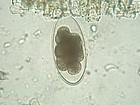Difference between revisions of "Nematodirus"
| Line 1: | Line 1: | ||
| + | Also known as; | ||
| + | {| cellpadding="10" cellspacing="0" border="1" | ||
| + | | Predilection site | ||
| + | | Small intestine | ||
| + | |- | ||
| + | |} | ||
| + | |||
| + | ===Introduction=== | ||
| + | ''N. battus'' is most prominent within the UK, but is also present to a lesser extend in Norway, Sweden, the Netherlands, and Canada. In heavy infections this parasite can be severe, and if left untreated can lead to the death of the carrying host. | ||
| + | |||
| + | It is a nematode , and is part of the '''Trichostrongyloidea''' superfamily. | ||
| + | |||
| + | ===Hosts=== | ||
| + | Mainly sheep and goats, but infected cattle are occassionally found. | ||
| + | |||
| + | ===Life Cycle=== | ||
| + | The lifecycle of ''N. battus'' is different from to the common '''Trichostrongyle''' lifecycle. | ||
| + | |||
| + | L1-L3 occurs within the egg. The larvae takes several months to develop. Hatching is stimulated by a cold period followed by a night/day temperature of around 10 degrees. The L3 are highly susceptible to changes in climate, so must be ingested soon after moulting to ensure the success of infection. | ||
| + | |||
| + | Pathology is seen when large number of '''larvae''' inhabit the small intestine. | ||
| + | |||
| + | ''N. battus'' can only hatch from eggs excreted on to pasture in the previous year. | ||
| + | |||
===Identification=== | ===Identification=== | ||
A mature adult is around 2cm longer. The female has a prominent spine projecting from the end. The male has a very long slender tail with spicules extended past the bursa. | A mature adult is around 2cm longer. The female has a prominent spine projecting from the end. The male has a very long slender tail with spicules extended past the bursa. | ||
| + | |||
| + | ''N. battus'' eggs are larger than the typical egg of a '''Trichostrongyle''', and have a brownish colouration. | ||
* A cause of parasitic [[Enteritis, Parasitic|catarrhal enteritis]]. | * A cause of parasitic [[Enteritis, Parasitic|catarrhal enteritis]]. | ||
Revision as of 14:10, 9 July 2010
Also known as;
| Predilection site | Small intestine |
Introduction
N. battus is most prominent within the UK, but is also present to a lesser extend in Norway, Sweden, the Netherlands, and Canada. In heavy infections this parasite can be severe, and if left untreated can lead to the death of the carrying host.
It is a nematode , and is part of the Trichostrongyloidea superfamily.
Hosts
Mainly sheep and goats, but infected cattle are occassionally found.
Life Cycle
The lifecycle of N. battus is different from to the common Trichostrongyle lifecycle.
L1-L3 occurs within the egg. The larvae takes several months to develop. Hatching is stimulated by a cold period followed by a night/day temperature of around 10 degrees. The L3 are highly susceptible to changes in climate, so must be ingested soon after moulting to ensure the success of infection.
Pathology is seen when large number of larvae inhabit the small intestine.
N. battus can only hatch from eggs excreted on to pasture in the previous year.
Identification
A mature adult is around 2cm longer. The female has a prominent spine projecting from the end. The male has a very long slender tail with spicules extended past the bursa.
N. battus eggs are larger than the typical egg of a Trichostrongyle, and have a brownish colouration.
- A cause of parasitic catarrhal enteritis.
